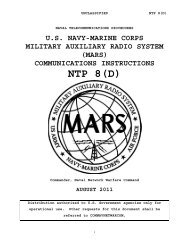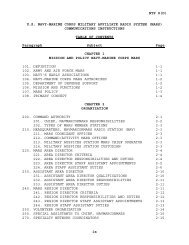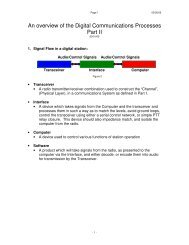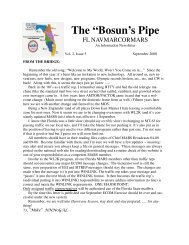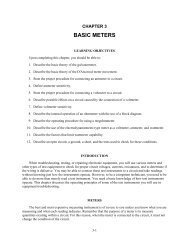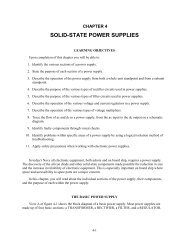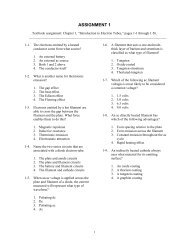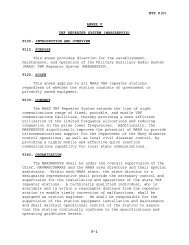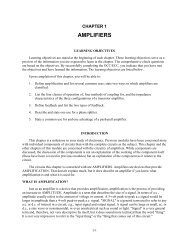Create successful ePaper yourself
Turn your PDF publications into a flip-book with our unique Google optimized e-Paper software.
E = I × RE = (10 × 10 -3 amperes) × (10 × 10 3 ohms)E = (10 × 10 -3 ) × (10 × 10 3 )E = 10 × 10E = 100 voltsBy applying +3 volts to the grid, the voltage drop across R L was increased by 50 volts (from theoriginal 50 volts to 100 volts). In view (C), -3 volts has once again been applied to the control grid. Onceagain plate current decreases to 2.5 milliamperes, and the voltage drop across R L drops to 25 volts.We have caused the voltage across R L to vary by varying the grid voltage; but is it amplification?Well, let's take a look at it. The grid voltage, or input signal, varies from +3 to -3 volts, or 6 volts. Thevoltage drop across R L varies from 25 volts to 100 volts, or 75 volts. In other words, the triode has causeda 6-volt input signal (varying) to be outputted as a signal that varies by 75 volts. That's amplification!Q13. What is the primary difference between a diode and a triode?Q14. Why does the grid have a greater effect than the plate on electron flow through a vacuum tube?Q15. What component is used in a triode amplifier to convert variation in current flow to voltagevariation?Let's summarize what you have learned so far:· A relatively small change in voltage on the grid causes a relatively large change in plate current.· By adding a plate-load resistor in series with the plate circuit, the changing plate current causes achanging voltage drop in the plate circuit.· Therefore, the small voltage change on the grid causes a large change of voltage in the platecircuit.· By this process, the small input signal on the grid has been amplified to a large output signalvoltage in the plate circuit.We'll leave De Forest at this point. He showed that the control grid can, in fact, CONTROL platecurrent. He also showed that the changing plate current can create a changing plate voltage. To somedegree, his changing voltages and currents also changed the world.<strong>INTRODUCTION</strong> <strong>TO</strong> GRID BIASWe purposely left out several features of practical triode circuits from the circuits we just discussed.We did so to present the idea of grid control more simply. One of these features is grid bias.Let's take another look at the circuit in figure 1-15(B). We found that the positive charge on the gridcaused more plate current to flow. However, when the grid becomes positive, it begins to act like a smallplate. It draws a few electrons from the space charge. These electrons flow from the cathode across thegap to the positive grid, and back through the external grid circuit to the cathode. This flow is known asgrid current. In some tube applications, grid current is desired. In others it is relatively harmless, while insome, grid current causes problems and must be eliminated.1-22




